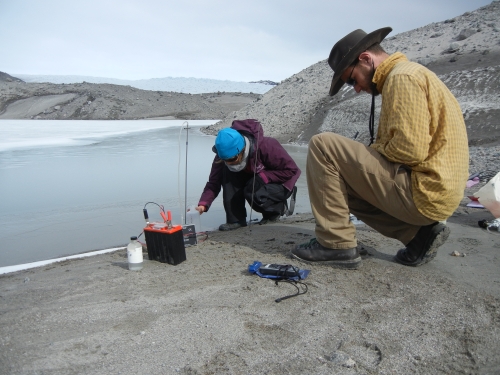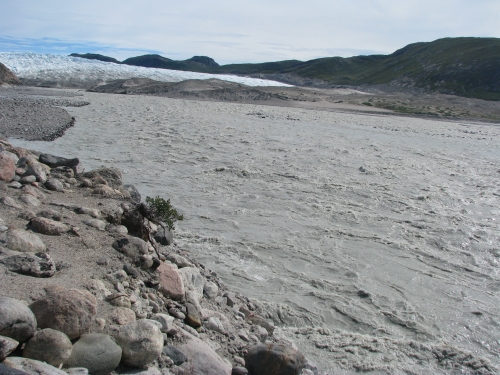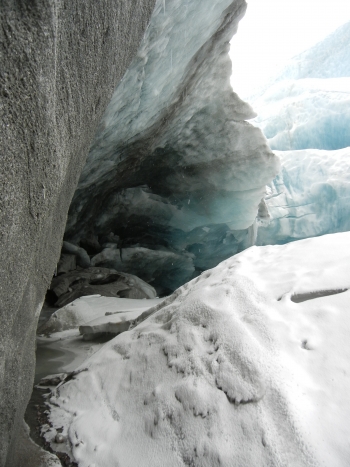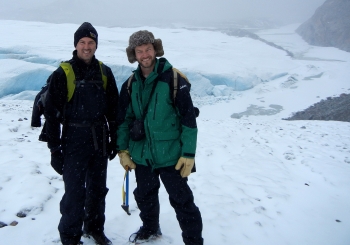By: Matthew A. Charette, Senior Scientist in Marine Chemistry and Geochemistry at the Woods Hole Oceanographic Institute
Introduction
During the second week of July 2012, satellite-derived estimates of the aerial extent of surface-ice melt on the Greenland Ice Sheet (GrIS) increased from 40% to 97%. Although this event received widespread media attention and public interest, the scientific community lacked direct observations of meltwater controls on ice sheet movement and meltwater geochemistry for such a large-scale melting event. Matt Charette, Senior Scientist of Marine Chemistry and Geochemistry at Woods Hole Oceanographic Institute (WHOI), secured funding through NSF's Rapid Response Research (RAPID) program to quantify, under a short time-frame, the impact of this large-scale melting event on the ice sheet dynamics and meltwater biogeochemistry of the Leverett Glacier, a large land-terminating ice stream along the southwestern coast of Greenland.

The project included analysis and synthesis of GrIS dynamics and of samples collected during previous field seasons (2011-12) from the Leverett Glacier catchment. One objective was to help interpret changes driven by the historic melt event of 8-12 July 2012. In addition, Charette and PhD student Ben Linhoff collected a high-resolution time series of radon concentrations in meltwater during the course of the melting season.
Radon is produced from the radioactive decay of naturally occurring uranium in sediments and rocks. Surface snow and ice are assumed to be devoid of radon due to lack of sediment on the ice sheet surface from which it could be derived; consequently it is assumed that all radon in glacial meltwater must be derived from contact with terrestrial material beneath the ice, a process analogous to recharge of groundwater aquifers via precipitation. Based on these assumptions, Charette and Linhoff hypothesized that radon concentrations in glacial meltwater would be elevated during periods when water was under pressure at the bed (high glacier velocity) and that radon would be low during periods of low pressure (low glacier velocity).
Preliminary Results
Preliminary results based on radon measured in the Leverett proglacial river suggest that meltwater contains a mix of high radon sourced from subglacial groundwater and low radon from water transported quickly through channels at the ice bed interface. The former was enriched during the early season, April and May, when the drainage network beneath the ice was poorly developed. As the melting season progressed during June and July, a series of large, radon-rich meltwater outbursts presumably led to an efficient channelized drainage network that persisted through the remainder of the summer as evidenced by relatively low river radon concentrations.

In addition to the contrast between early and late season subglacial meltwater dynamics, interannual variability was of interest given possible enhanced ice sheet melting associated with climate change. The WHOI team was in Greenland when the major melting event took place: between 8-12 July 2012. During this event, the size of the Leverett River swelled to four times the size of the peak flow observed during 2011. Despite this intense warming event, annually averaged Leverett Glacier sliding rates were not appreciably different between the two years as reported by Charette and Linhoff's colleagues at the University of Edinburgh (Tedstone et al. 2013).

These findings have important implications for the effects of surface melt-induced acceleration of land terminating glaciers. There may also be consequences of enhanced melting on trace element and isotope fluxes to the ocean; analyses of discrete samples collected for this purpose from the Leverett River are currently underway in the team's laboratory. These sample collections and analyses would not have been possible without support from NSF through its RAPID program–encouraged by Polar Program managers contacted by Charette soon after the extreme melting took place in July 2012.
Further details on the 2012 expedition are available in a Scientific American blog written by Linhoff entitled "Following the Ice". A video profile and short video on the 2012 extreme melting event are also available.
This project was funded by the Woods Hole Oceanographic Institution's Arctic Research Initiative and Ocean Ventures Fund as well as the National Science Foundation's Office of Polar Programs.
For further information, contact Matthew Charette (mcharette [at] whoi.edu).
References
Tedstone et al. 2013. Greenland ice sheet motion insensitive to exceptional meltwater forcing. Proceedings of the National Academy of Sciences of the United States of America. Vol. 110, No. 49. http://www.pnas.org/content/110/49/19719.

Ben Linhoff is a PhD student in the Massachusetts Institute of Technology/Woods Hole Oceanographic Institute (MIT/WHOI) Joint Program in Oceanography.
